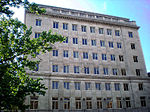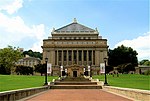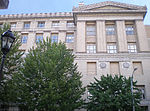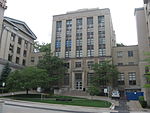University Club (University of Pittsburgh)
1923 establishments in PennsylvaniaClubhouses on the National Register of Historic Places in PennsylvaniaFaculty clubsHenry Hornbostel buildingsHistoric district contributing properties in Pennsylvania ... and 4 more
NRHP infobox with nocatNational Register of Historic Places in PittsburghUniversity and college buildings on the National Register of Historic Places in PennsylvaniaUniversity of Pittsburgh buildings

The University Club is an eight-story building of the University of Pittsburgh designed by Henry Hornbostel and completed in 1923 that is a contributing property to the Schenley Farms Historic District on the school's campus in Pittsburgh, Pennsylvania, United States. It serves as a faculty club with publicly accessible dining, banquet, and conference facilities, while the upper four floors serve as housing for the families of out-of-town hospital patients.
Excerpt from the Wikipedia article University Club (University of Pittsburgh) (License: CC BY-SA 3.0, Authors, Images).University Club (University of Pittsburgh)
Fifth Avenue, Pittsburgh
Geographical coordinates (GPS) Address Website Nearby Places Show on map
Geographical coordinates (GPS)
| Latitude | Longitude |
|---|---|
| N 40.444291666667 ° | E -79.956758333333 ° |
Address
University of Pittsburgh (Pitt)
Fifth Avenue 4200
15260 Pittsburgh
Pennsylvania, United States
Open on Google Maps










